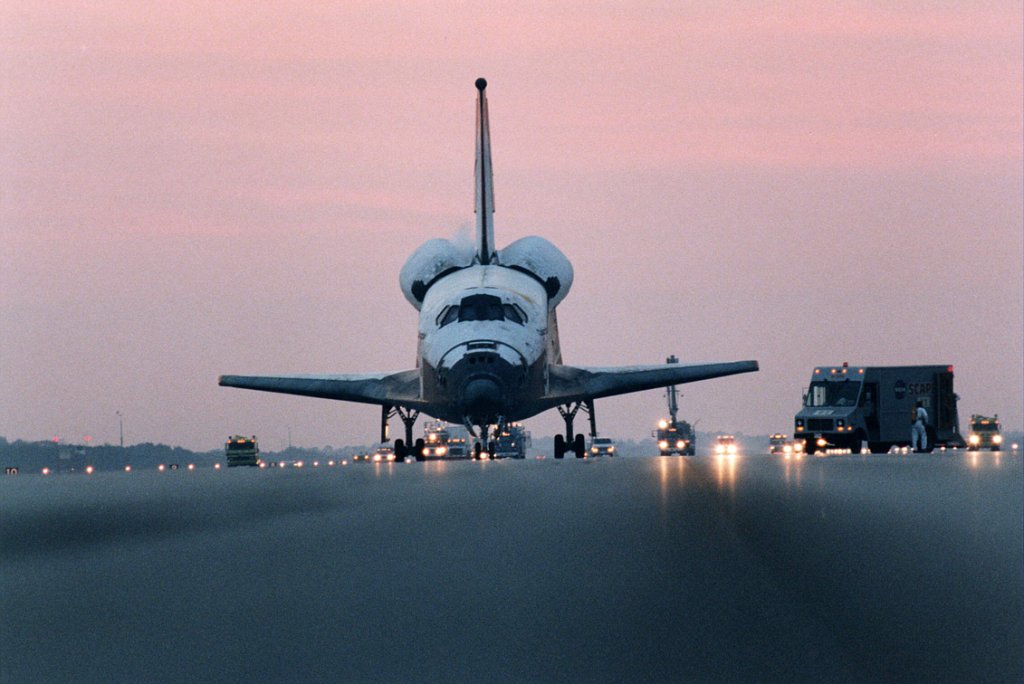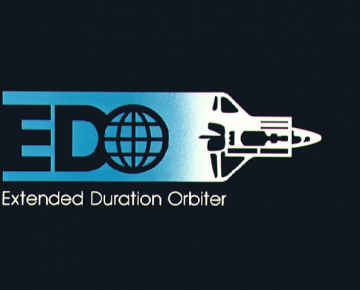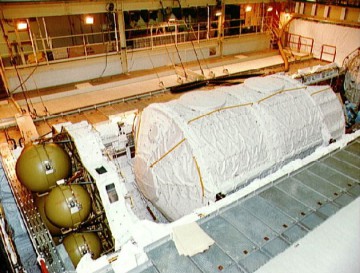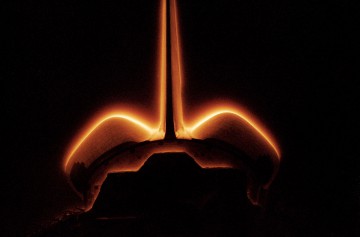
Twenty-five years ago, this week, NASA and Rockwell International reached a historic agreement which would, both figuratively and literally, “extend” the shuttle and its myriad capabilities beyond anything previously achievable. On 2 April 1990, a Memorandum of Understanding (MOU) was signed, requiring Rockwell—the shuttle’s prime contractor—to “produce commercially a cryogenic pallet” for the long-planned Extended Duration Orbiter (EDO) program, which sought to stretch missions beyond the nominal week to at least 16 days and perhaps further to 28 days. That contract enabled 14 long-duration missions between June 1992 and February 2003, which supported hundreds of scientific investigations, deployed and retrieved satellites, and transformed the shuttle into a miniature space station. In fact, when one excludes Skylab and ISS expeditions, EDO allowed the shuttle to fly for almost 18 days, marking the longest “standalone” U.S. space mission of all time.
Lengthening shuttle flights beyond their nominal one-week duration had been in the back of NASA’s mind since the pre-Challenger era, as a means of evaluating crew dynamics in a closed environment and offering the scope to perform scientific research for longer than was previously possible. In June 1988, shortly before shuttle operations resumed with STS-26, NASA and Rockwell amended their main contract, whose language provided for the development of the EDO hardware and modifications to Columbia—at the time the only orbiter with as many as five liquid oxygen and hydrogen cryogenic reactant tanks underneath her payload bay floor—in order to accommodate it.
“NASA will reimburse Rockwell in three yearly instalments after the pallet has been delivered in December 1991,” the space agency announced. “NASA will offer the use of the EDO mission kits as an optional service to all shuttle customers.” One such customer was Germany, which was offered the chance to have the EDO pallet aboard its dedicated Spacelab-D2 mission. “They had a trade-off they could’ve had there,” astronaut Steve Nagel told the NASA Oral History Project. “Could’ve put a pallet in the back with my cryo for fuel cells and flown even longer, but they chose to have experiments back there on an outside rack, instead of additional days on-orbit.”

With the ink on the NASA-Rockwell contract dry, efforts moved into high gear to remove Columbia from service in mid-1991 for the EDO modifications, after which the first 13-day mission would be attempted as soon as March 1992. Over the course of the following 3.5 years, through September 1995, it was expected that Columbia would support a total of six EDO missions, primarily for the carriage of Spacelab research payloads. Late in 1990, the crew was announced for STS-50—the first EDO mission, carrying the first U.S. Microgravity Laboratory (USML-1)—and in January 1991 NASA modified its shuttle production contract with Rockwell by $93.5 million. “Under the terms of the modification,” noted a news release, “Rockwell is required to modify the Columbia orbiter to extend the mission duration of flights from ten days to 16 days, plus a two-day contingency.”
Upgrading Columbia to accept EDO got underway within weeks of her return from the STS-40 mission in June 1991. Later that summer, she was transported from the Kennedy Space Center (KSC) in Florida, via the Boeing 747 Shuttle Carrier Aircraft (SCA), to Rockwell’s facility in Palmdale, Calif., where she spent six months receiving more than 150 modifications, including the 3,600-pound (1,630-kg) EDO pallet. Nicknamed “The Wafer,” the pallet measured 15 feet (4.6 meters) in diameter and occupied an upright position at the aft end of the payload bay. It housed four liquid oxygen tanks, two liquid hydrogen tanks, and a pair of helium tanks, with option to accommodate a greater number for flights up to the 28-day maximum. When fully loaded, the pallet could store 3,130 pounds (1,420 kg) of liquid oxygen and 368 pounds (167 kg) of liquid hydrogen, which pushed its overall weight to almost 7,000 pounds (3,180 kg).
Additionally, the Regenerative Carbon Dioxide Removal System (RCRS) provided a method for removing the crew’s exhaled carbon dioxide from the cabin in a more efficient manner than had been previously achievable with lithium hydroxide canisters. It worked by means of adsorption, instead of absorption. “It uses amine, coated on very small beads, almost like a powder,” said Frank Samonski, then-chief of NASA’s Environmental Control and Life Support Systems Branch, “but it pours like sand into a multi-layered bed, like a heat exchanger. When you pass gas containing carbon dioxide and moisture over it, the moisture activates this coating and the carbon dioxide molecules stick the coating. It’s not a chemical bond and can be broken by exposure to vacuum. One bed is ‘online’, collecting CO2, and the other is ‘desorbing’ to space vacuum. Through a series of valves, you switch those beds and dump the CO2 overboard in a cyclic manner. It’s not good for long-term missions like the space station, but it’s just right for the shuttle.” As well as the pallet, two extra nitrogen tanks were added to Columbia to support the crew cabin and several more stowage lockers were installed in the orbiter’s middeck.

In tandem with this work, NASA’s newest shuttle, Endeavour, had also been equipped with the EDO hardware during her construction, together with the capability to house two pallets in her payload bay and thus enable 28-day missions. A fifth liquid oxygen tank and a fifth liquid hydrogen tank beneath her payload bay floor supported this provision. Although the official plans at the time called for Columbia alone to fly EDO missions, Endeavour would perform one such flight—STS-67, carrying the ASTRO-2 payload in March 1995—before the hardware was removed for weight-saving reasons, ahead of the International Space Station (ISS) construction era, in 1996.
The man who went on to command the shuttle’s first EDO mission was Dick Richards, whose two previous flights had been short in duration. After returning from the four-day STS-41 mission in October 1990, he had complained to Chief Astronaut Dan Brandenstein about the issue. “I just raved … about the fact that I can’t believe we’re going up there and spending four days,” he told the NASA Oral History Project, “so they said, okay, we’ve got this flight coming off, called United States Microgravity Laboratory.” In December 1990, Richards was assigned as its commander.
Eighteen months later, in June 1992, Columbia was at Pad 39A and the EDO provisions required several changes to her processing regime. Technicians rehearsed loading the cryogens aboard the pallet, in order to establish “realistic” timelines for these procedures, and on its first mission it performed admirably. It suffered a minor liquid oxygen leak, early in the flight, but the Mission Management Team (MMT) elected to use the leaky tank first, in order to reduce wastage. The RCRS, on the other hand, failed six times and required the crew to load backup lithium hydroxide canisters in the shuttle’s cabin and aboard the Spacelab module. It later became clear that faulty sensors pertaining to internal valves were causing it to prematurely shut itself down and a lengthy repair procedure by the astronauts eventually brought it, belching and wheezing, back to life.
By the time Columbia returned to Earth on 9 July 1992, she had recorded a new shuttle duration record of 13 days, 19 hours, and 30 minutes, which eclipsed by almost three full days the previous achievement at the end of STS-32. Additionally, it had exceeded, by just 55 minutes, the achievement set at the end of the Gemini VII mission in December 1965. Until then—and with the exception of the three Skylab expeditions—Gemini VII had retained the record for the longest “standalone” U.S. piloted spaceflight.

Over the following decade, a further 13 EDO missions took place. On STS-58 in October-November 1993, astronauts John Blaha and Rick Searfoss utilized a computer program known as the Portable In-Flight Landing Operations Trainer (PILOT), which comprised a high-resolution color display and hand controller to offer them the “look” and “feel” of the orbiter, whilst in space. They assembled it on the console in front of the pilot’s seat on the flight deck and attached its joystick to Searfoss’ hand controller, as part of efforts to keep their approach and landing skills sharp during prolonged weightlessness. Physical conditioning of the astronauts in readiness for EDO missions had already been undertaken by several previous shuttle flights and the EDO Medical Project (EDOMP) included a Lower Body Negative Pressure (LBNP) suit—an inflatable cylinder, four feet (1.2 meters) tall, which sealed around the waist and drew fluids into the legs to offset the upward fluid shift which tends to occur in microgravity—and an elevated exercise regime. “During re-entry,” noted Dick Richards, “you have to have a strong cardiovascular response, particularly during the final phase.”
STS-58 pushed the EDO lead yet further to 14 days and 12 minutes, with another extended mission—STS-62 in March 1994—coming close at 13 days, 23 hours, and 16 minutes. Although this was the originally planned duration of the mission, it had been hoped that STS-62 might be extended, but it was not to be. “It would have been nice to get the record,” said Commander John Casper, “but I think we did a lot of good things.” Four months later, in July 1994, STS-65 secured a new record of 14 days, 17 hours, and 55 minutes for the shuttle fleet, but Columbia lost her crown in March 1995 when Endeavour staged her first (and only) EDO mission, STS-67. That flight was always expected to seize the endurance record, with a scheduled length of 15 days and 13 hours, but by the time Endeavour returned to Earth, she had completed a voyage of 16 days, 15 hours, and eight minutes, which established the mission as the longest in shuttle history at that time. Even today, following the retirement of the fleet of orbiters, STS-67 retains a place as the third longest flight in shuttle history and the third longest U.S. non-space station mission of all time.
Original planning had called for a third orbiter, Atlantis, to receive EDO enhancements, and during a period of modification and refurbishment in 1992-1994 she was outfitted with internal plumbing and electrical provisions to enable longer flights. However, the wafer pallet was never fully incorporated or used and Atlantis never embarked on an EDO mission. As a consequence, it was Columbia—the queen of the fleet—which flew out the remaining nine extended flights. From October 1995 through to her tragic loss during re-entry on STS-107 on 1 February 2003, she pushed the shuttle program’s endurance record progressively further. On STS-78 in June-July 1996, she completed a mission of 16 days, 21 hours, and 48 minutes, an accomplishment which she went on to break on her very next flight, STS-80, in November-December of that year, when she flew for 17 days, 15 hours, and 53 minutes. In wrapping up STS-80, Columbia circled Earth on 279 occasions. It is also fitting that Columbia’s final voyage, which ended in disaster shortly before landing, established itself as the fourth longest mission in shuttle history, at 15 days, 22 hours, and 20 minutes.
Had Columbia—and the EDO pallet—survived re-entry on the morning of 1 February 2003, it is unclear if another long-duration shuttle flight would have been undertaken. At the turn of the millennium, there existed plans for a series of “Research Missions,” although by the time of her loss Columbia was firmly booked for a voyage to the International Space Station (ISS) and a servicing of the Hubble Space Telescope (HST), both of which would probably have run to about 11 days. It seems likely, therefore, that with or without the calamity which befell STS-107, Columbia’s EDO adventure was at an end. In any case, long-duration and permanent occupation of the International Space Station (ISS) was by this point well-established. Yet it remains a fitting tribute that, until the very end of the shuttle era in July 2011, the queen of the fleet retained her record for the longest non-space station flight in U.S. history.
Want to keep up-to-date with all things space? Be sure to “Like” AmericaSpace on Facebook and follow us on Twitter: @AmericaSpace




I have commented before a couple times on different sites my view that the ISS was never really needed for 6 month astronaut missions- that a shuttle could be loaded with these pallets and do it. I further ventured that since the shuttle had to be landed manually that another shuttle would have to to go up and transfer a healthy pilot not affected by microgravity debilitation to perform the landing.
So many if only this and that I know. I am not a huge shuttle fan but I do not demonize like so many people do either. It was what it was and worth every cent if we just learn from it. One lesson (there are many) I take away from the whole saga is that LEO is a dead end. The take-it-up-to-LEO-in-little-pieces was 100 to 200 billion dollars (by various pricing estimations) of proof that it does not work. Yet here we are with the flexible path trying to do it all over again.
We need to go back to the Moon.
Gary, yes it’s expensive to get things up to LEO. But you have to get them to LEO, and far beyond, before you get them to the moon. You aren’t going to save anything by putting things on the moon instead of in LEO.
Charles, bypassing the dead end of LEO with Super Heavy Lift Vehicles and going direct to the Moon dumps the NewSpace business plan in the trashcan. So I can understand why putting things in LEO is what you want to emphasize as a savings of some kind.
I do agree with all the ideas you have introduced on your post. They are really convincing and can certainly work. Nonetheless, the posts are very brief for novices. May you please prolong them a bit from next time? Thank you for the post.|